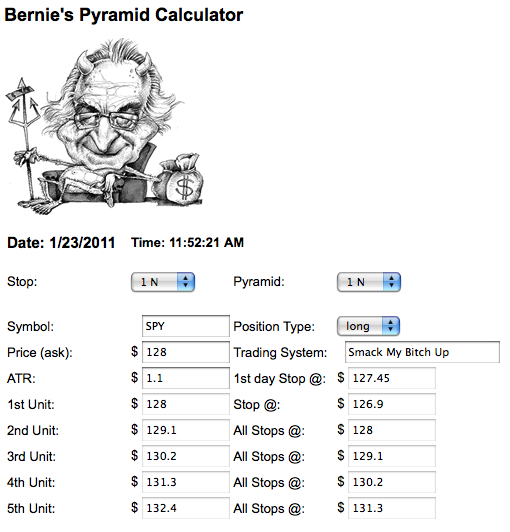
Pyramiding Positions
Now trend traders often pyramid their positions, so that means that once a trade is going in your favor you add another ‘unit’. Again, I do that by using a multiple of my risk exposure, which in turn was defined by ATR. You can of course use an arbitrary stop in which case you use multiples of whatever your entry/stop delta comes out to. Some trend traders add up to three or four units and you should really count your blessings at five units. As you can imagine calculating this entire scheme gets rather complicated quickly and use up a lot of your trading time. And that brings me to your new favorite toy: Bernie’s Pyramid Calculator (BPC) – a trading tool exclusive to Evil Speculator subscribers:
If you are a subscriber you can click on the image above to get to the BPC – it’s also available in the menu bar on top.
I have set the entry price here to 128, just like in Scott’s setup in my first chart. Not to beat a dead horse, but in order to use this tool you need to first figure out how much you want to lose on each position. And I phrase this intentionally that way – when I enter into a position my base assumption always always is that I am wrong. That affords me the luxury of staying cool when my stop gets hit and to be happy when I wound up being right. When it comes to calculating your risk my tip would be define your risk exposure in the BPC first and then to use to TOS simulator to calculate how many shares or options you can buy/sell based on your 1% risk rule. If you use a 1N stop you can obviously get into more positions than with a 2N rule – this is all up to you and maybe I will cover this topic another time. I know it all sounds horribly complicated but once you’ve done it once or twice it’ll become second nature.
Now, the first thing you do is to add the symbol for posterity’s sake- the script automatically puts it into upper case. Then you enter the ask price and if you want you can also name the trading system use for this position (always helpful a week later if you’re suffering from ADHD). Next you use the daily ATR of the particular symbol to define your stop – I usually use a 14-day ATR – but 10 is fine in more volatile times. The rest happens automagically – you immediately know your first stop without having to resort to complex trigonometry and even your entry day stop at 0.5 x whatever your N is, if that’s part of your system. Even better – you also get your future pyramid triggers and you can add those as timed entries (price trigger and time) in ThinkOrSwim.
When I take a position like this I usually also use jing to produce a screen grab of my trade. That’s why I also added the date and time on top of the BPC, it tells me exactly when the trade was taken. You can either print it out or add it to your private trading blog – I personally prefer latter. What happens next is up to the tape. Either you get stopped out and you’re done, or the tape moves in your favor and that means you have some work to do. You can either trade each additional unit manually or do it via triggers in TOS – there are pros and cons to either. I like to do it manually as I also consider the velocity and ‘feel’ of the tape – but if I’m honest I need to concede that I often slept through adding additional units.
And there you have it. Pyramid trend trading made easy – even for the mathematically challenged. If you look at the SPY chart above you see that the 1N stop used in the example came out to just where we would want it – below the 127.13 prior low at 126.9. I prefer that to 127 as integers often get hit in stop sweeps. Even when I take discretionary trades I prefer to set my stop at non integers.
Again, the tool is exclusive to subscribers and I hope that all of you stainless steel rats will find it to be a welcome tool in your trend trading arsenal.





